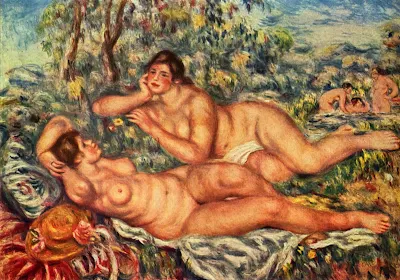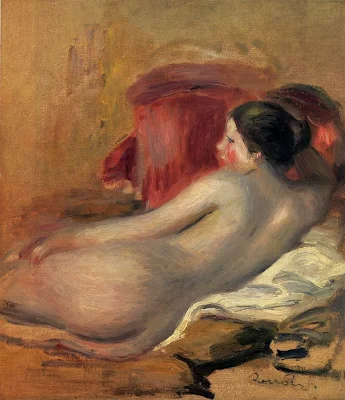Nude aka Study for 'The Large Bathers'
Το
γυμνό είναι αναντίρρητα το αγαπημένο θέμα του Ρενουάρ, τον απασχόλησε σε όλη τη
δημιουργική του πορεία μέχρι τις τελευταίες μέρες της ζωής του και ως εκ τούτου
αποτυπώνει την εξέλιξη της τέχνης του. Καθώς εισχωρούμε στο προσωπικό σύμπαν
του ζωγράφου, βυθιζόμαστε σε έναν κόσμο απόλυτα αισθησιακό και αθώο, όπου η
γυναικεία μορφή ακτινοβολεί χωρίς περιορισμούς.
After Bathing (nude study)
Τη
γυναίκα ως νύμφη, λουόμενη, γυναίκα-ανθό ή γυναίκα καρπό, την προτιμά εύσαρκη
και γλυκιά, με πλούσιο στήθος, γεμάτη κοιλιά, φιλντισένιο δέρμα. Από το έργο
του θα δημιουργηθεί μια γυναίκα αρχέτυπο, την οποία σήμερα πια χαρακτηρίζουμε
χωρίς ενδοιασμούς "γυναίκα του Ρενουάρ".
After Bathing, Seated Female
Nude
The magic of Renoir
was not just in his compositions but in his choice of subjects. The women he
painted, the curves of their voluptuous bodies and their ages were all part of
his genius. Adding to the incredible attraction to these creations, was his
soft color choices. His women were full figured, women, not children, women
with women’s bodies. Renoir celebrated the body of a woman in all her glory.
Baigneuse (Baigneuse blonde
I)
Baigneuse assise sur un
rocher
Bather 02
Bather 03
Bather 04
Bather 05
Bather Drying Her Feet
Bather Seated by the Sea
Bather
Bather, Seated Nude
Bathers 02
Bathers 03
Bathers
La dormeuse (La baigneuse endormie)
Nude Arranging Her Hair
Nude Bather Seated by the Sea
Nude in a Straw Hat
Nude in an Armchair
Nude on a Couch
Nude on the Grass
Nude reclining on cushions
Nude Reclining on the Grass
Nude Seated in a Landscape
Nude Seated on a Sofa
Nude Sitting in the Forest
Nude Woman on Green Cushions
Ode to Flowers (after Anacreon)
Reclining Model
Reclining Nude 02
Reclining Nude aka The Baker's Wife
Reclining Semi-Nude
Seated Bather
Seated Bather 02
Seated Bather 03
Seated Bather 04
Seated Bather 05
Seated Female Nude
Seated Nude 02
Seated Nude 03
Seated Nude aka At East
Seated Nude in Profile aka Gabrielle
Seated Nude with a Bouquet
Seated Nude
Standing Bather 02
Standing Bather
The Bathers
Torse au soleil
"Δεν θα μπορούσα να εργαστώ χωρίς μοντέλο, πρέπει όμως να μπορείς να ξεχνάς το μοντέλο, αλλιώς το έργο σου θα αναδίδει μυρωδιά μασχάλης". Πιερ Ωγκύστ Ρενουάρ


.jpg)



,+1881,+Sterling+and+Francine+Clark+Art+Institute,+Williamstown,+Massachusetts.jpg)















,+1897,+Oskar+Reinhart+Collection,+Winterthur.jpg)




















.jpg)



























